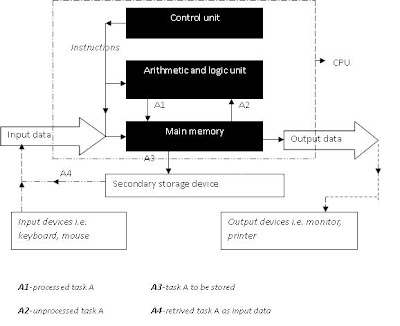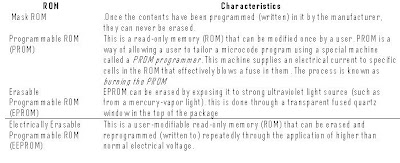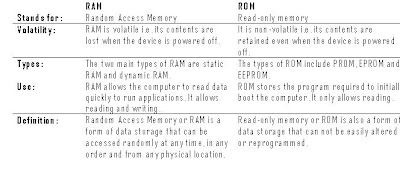PROCESSING DEVICES
Download free latest unlimited KCSE revision papers @ www.manyamfranchise.com -
Author: Atika M. Nyamoti
Data stored in ROM cannot be modified, or can be modified only slowly or with difficulty
It is mainly used to distribute firmware (software that is very closely tied to specific hardware and unlikely to need frequent updates)
RAM (random access memory) is the place in a computer where the operating system, application programs, and data in current use are kept so that they can be quickly reached by the computer's processor. RAM is much faster to read from and write to than the other kinds of storage in a computer, the hard disk, floppy disk, and CD-ROM.
However, the data in RAM stays there only as long as your computer is running. When you turn the computer off, RAM loses its data. When you turn your computer on again, your operating system and other files are once again loaded into RAM, usually from your hard disk
PROCESSING DEVICES
THE CENTRAL PROCESSING UNIT(CPU)
The CPU also known as the processor is mounted on the system board (mother board) inside the system unit. It’s regarded as the brain of the computer because it does all the processing activities in the computer. The figures below shows the top and bottom view of a the CPU respectively. |
| Top View of CPU |

BOTTOM VIEW OF THE CPU

Parts of the CPU
The CPU consists of three main elements as shown in the
diagram below.
 |
Parts of the CPU
|
The CPU Speed, Links, History, Speed and Types
- The speed of
the CPU is measured in HERTZ (HZ). i.e.,
number of operations that can be done per second. Heat is
released when CPUs run. High temperature, however, decrease the performance of
CPU. You, therefore, need a fan to cool down the CPU. You can change the
speed of CPU in BIOS of your computer. Some people change the speed of their
CPU to a very high MHz. This can increase the speed of the computer but would
make the CPU overload and overheat. Finally, the whole computer may break down.
Therefore, it is not recommend doing so.
-Links/ Pathways- the
ALU, the main memory and the control unit use electrical pathways/links called buses to communicate to one another.
These buses include:
- Ø Control bus- it’s a pathway for all timing and controlling functions sent by the control unit to other parts of the system.
- Ø Address bus- it’s a pathway used to locate the storage position in memory where the next instruction data to be processed is held
- Ø Data bus- it’s a pathway where the actual data transfer takes place.
History of the CPU
-Types of the CPU
There aren't really different types of CPU, but there are
some major differences between CPUs. Like Bus Sizes - we have 32 & 64 bits.
But there are different processor architectures namely:
- Ø CISC: Complex Instruction Set Computers
- Ø RISC: Reduced instruction Set Computers
- Ø MISC: Minimal Instruction Set Computers
CISC (Complex Instruction Set
Computers)
This is a computer where single instructions can execute several low-level operations. Examples of CISC
instruction set architectures are System/360 through z/Architecture, PDP-11, VAX, Motorola
68k, and x86.
RISC (Reduced
instruction Set Computers)
This is a CPU
design strategy that uses fewer instructions set compared to CISC.
Well known RISC families include DEC Alpha, AMD 29k, ARC, ARM, Atmel AVR, Blackfin, MIPS, PA-RISC, Power (including Power-PC), Super H, and SPARC.
MISC (Minimal
Instruction Set Computers)
This is processor architecture
with a very small number of basic operations and corresponding op codes.
Probably the most
commercially successful MISC was the IN MOS
transputer.
Control Unit
Co-ordinate all the processing activities in the CPU as well as input, storage and output operations. The CPU uses a system clock to coordinate these activities. The system clock also determines the speed of the CPU. The higher the number of cycles/pulses per second which is also called frequency the faster the CPU.Arithmetic and logic unit
this is a unit
in the CPU where all the logical and arithmetic operations are carried out. It
does this by decoding instructions from the control unit to processes data.
Some of the arithmetic operations include: addition, subtraction, division,
multiplication etc. logical operations include: less than, equal to, greater
than, sorting, filtering etc
Main memory
The main memory is also called primary storage. It stores data that is directly accessible by the CPU. The main memory of a computer can be classified as RAM (random access memory) and ROM (read only memory)Read only memory (ROM)
This is a class of storage medium used in computers and other electronic devices.Data stored in ROM cannot be modified, or can be modified only slowly or with difficulty
 |
| Read Only Memory |
It is mainly used to distribute firmware (software that is very closely tied to specific hardware and unlikely to need frequent updates)
Types of ROM
 |
| Types of RAM |
Random Access Memory (RAM)
 |
| Random Access Memory |
However, the data in RAM stays there only as long as your computer is running. When you turn the computer off, RAM loses its data. When you turn your computer on again, your operating system and other files are once again loaded into RAM, usually from your hard disk
Type of RAM
- Static RAM (SRAM) - SRAM (static RAM) is random access memory (RAM) that retains data bits in its memory as long as power is being supplied. Static RAM provides faster access to data and is more expensive than DRAM. SRAM is used for a computer's cache memory and as part of the random access memory digital-to-analog converter on a video card.
- Dynamic RAM (DRAM) - Dynamic random access memory (DRAM) is the most common kind of random access memory (RAM) for personal computers and workstations. It needs to have its storage cells refreshed or given a new electronic charge every few milliseconds. DRAM stores each bit in a storage cell consisting of a capacitor and a transistor. Capacitors tend to lose their charge rather quickly; thus, the need for recharging.
Static RAM vs. Dynamic RAM
 |
| Static vs Dynamic RAM |
RAM vs. ROM
 |
| RAM vs ROM |
Special purpose memories
These are types of memories housed in the CPU, system board,
input and output devices to enhance performance.
Types of special purpose memories:
-
Cache memory- A
CPU cache is a cache used by the central processing unit of a computer
to reduce the average time to access memory. The cache is a smaller, faster
memory which stores copies of the data from the most frequently used main
memory locations. As the microprocessor processes data, it looks first in the cache
memory and if it finds the data there (from a previous reading of data), it
does not have to do the more time-consuming reading of data from larger memory.
Cache memory is sometimes described in levels of closeness and accessibility to
the microprocessor. An L1 cache is on the same chip as the
microprocessor.
-
Buffers- a buffer
is a region of physical memory storage used to temporarily hold data while it
is being moved from one place to another. Typically, the data is stored in a
buffer as it is retrieved from an input device (such as a mouse) or just before
it is sent to an output device (such as speakers). However, a buffer may be
used when moving data between processes within a computer. Like a cache, a
buffer is a "midpoint holding place" but exist not so much to
accelerate the speed of an activity as to support the coordination of separate
activities.
-
Registers- a
processor register is a small amount of storage available as part of a CPU
or other digital processor. Such registers are (typically) addressed by
mechanisms other than main memory and can be accessed more quickly. Almost all
computers, load-store architecture or not, load data from a larger memory into
registers where it is used for arithmetic, manipulated, or tested, by some machine
instruction. Manipulated data is then often stored back in main memory, either
by the same instruction or a subsequent one.
Types of registers
 |
| Types of Registers |
Memory capacities
The SI unit for measuring memory and storage capacity is called bytes. A byte is a single character which can either be from 0-9, a-z, symbols and spaces.
Memory quantities can be expressed in:
Byte approx 8-bits
Kilobyte (KB) approx 1000
bytes
Megabyte (MB) approx 106 bytes
Gigabyte (GB) approx 109 bytes
Terabytes approx 1012 bytes
Hierarchy of storage
 |
| Types of computer storage |
-
Primary
storage (or main memory or internal
memory), often referred to
simply as memory, is the only one directly accessible to the CPU. Examples include: RAM, ROM, Cache
memory, Registers and buffers.
-
Secondary
storage (also known as external memory or
auxiliary storage), these memory permanently store data for future
reference. Secondary storage does not lose the data when the device is powered
down—it is non-volatile. Example: Hard
disk, Floppy disk.
-
Off- line
storage- In modern personal computers, most secondary and tertiary
storage media are also used for off-line storage. Off-line storage is computer
data storage on a medium or a device that is not under the control of a processing
unit. The medium is recorded, usually in a secondary or tertiary storage
device, and then physically removed or disconnected. Example: CD, DVD, Tapes, Floppy disk, Zip and Jazz disks etc.


